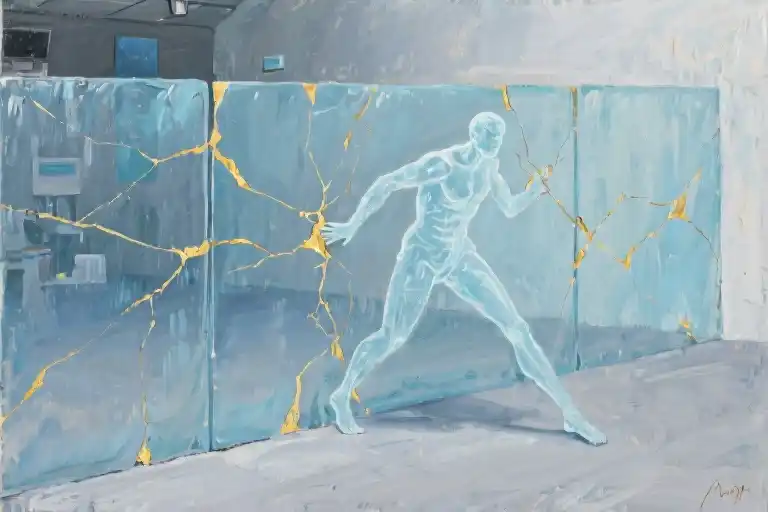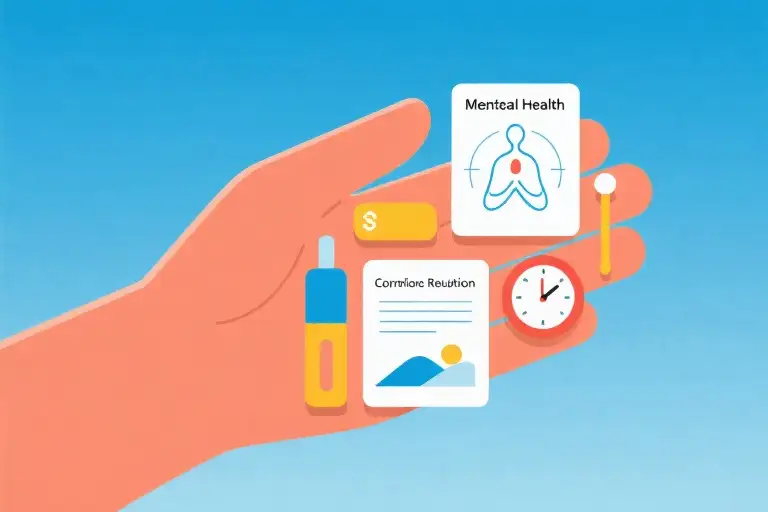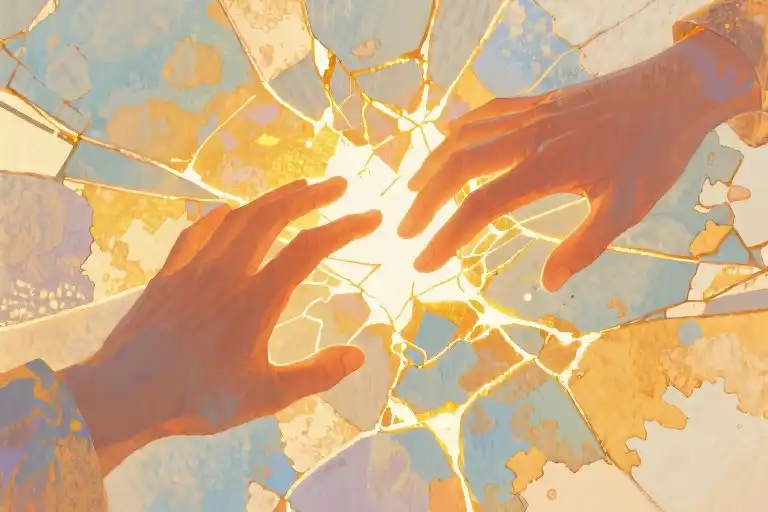There’s a particular kind of exhaustion that comes not from doing too much, but from feeling like you’re moving through wet concrete while everyone else seems to be walking on air. The architect who can’t sketch without hearing ‘not good enough’ in her pulse. The startup founder whose third-round funding feels like borrowed time. The teacher grading papers at 2am wondering when his passion became paperwork. These aren’t isolated stories—they’re the collective whisper of a generation trying to breathe through layers of invisible expectations.
The Stagnation Spectrum
Psychological research identifies three distinct flavors of this paralysis (though most of us experience a cocktail):
- Cognitive: When your brain’s internal GPS glitches, making familiar tasks feel like deciphering alien instructions (that ‘forgetting how to walk’ sensation)
- Emotional: The equivalent of living behind soundproof glass—you see life happening but can’t access the volume controls
- Existential: A profound disconnect between the story you’re living and the one you meant to write
Why Your Brain Sabotages Progress
That eerie sense of unrecognizable familiarity? Neuroscience explains it as your posterior cingulate cortex—the mental mapmaker—going offline during chronic stress. Like a smartphone stuck in power-saving mode, your cognitive resources get diverted to basic survival functions. The cruel irony? This often happens right when society expects peak performance.
|||
Micro-Exercise: Before reading further, notice where in your body you feel ‘stuck’ most acutely—is it chest tightness? Heaviness behind the eyes? This physical anchor makes abstract distress concrete.
|||
We’ve been conditioned to view stagnation as personal failure rather than what it often is: our nervous system’s last-ditch effort to prevent total burnout. The same neural pathways that helped you power through deadlines now rebel against what they perceive as unsustainable demands. Your mind isn’t broken—it’s trying to negotiate better working conditions.
Consider this permission: What if your hollow version isn’t the end of your story, but the necessary emptiness that makes reinvention possible? Like winter fields resting before spring, this fallow period might be preparing soil for growth you can’t yet imagine.
The Three Faces of Stagnation
That dull ache behind your ribs when you scroll through LinkedIn at 2 AM isn’t just fatigue—it’s your brain’s navigation system glitching. Modern neuroscience reveals we experience stagnation in three distinct dimensions, each with its own fingerprint on your nervous system.
Cognitive Stagnation: When Your Mental GPS Fails
You know that disorientation when Google Maps suddenly shows you floating in blue void instead of your expected route? Cognitive stagnation feels eerily similar—the pathways between your aspirations and daily actions seem severed. Studies from Johns Hopkins show chronic self-doubt physically shrinks the hippocampus, the brain’s cartography center. This explains why you might literally forget how to ‘walk’ through routines that once felt automatic.
Key markers:
- Re-reading the same paragraph multiple times without comprehension
- Blanking mid-conversation on familiar topics
- That ‘wait, what was I just doing?’ sensation occurring multiple times daily
Emotional Stagnation: Life in Plastic Wrap
Remember peeling cling film off leftovers and how it stubbornly readheres? Emotional stagnation creates that same suffocating seal—you see the world clearly but feel nothing. UCLA researchers found prolonged stress causes dendritic shrinkage in emotion-processing neurons, creating what one subject described as ‘watching my life through soundproof glass.’
Telltale signs:
- Laughing at jokes because you remember they’re funny, not because you feel amused
- Crying during movies but dry-eyed at personal milestones
- Food tasting like cardboard despite being your favorite meal
Existential Stagnation: The Black Hole of Self-Narrative
When astrophysicists describe stars being spaghettified by black holes, they might as well be explaining existential stagnation. Your personal narrative—the constellation of ‘I am’ statements that define you—gets stretched beyond recognition. Princeton’s narrative psychology lab found this creates neural activity patterns identical to physical disorientation.
Red flags:
- Reusing old anecdotes because you can’t identify with current experiences
- Avoiding mirrors not due to appearance but unrecognizability
- Saying ‘I used to be someone who…’ more than ‘I am…’
What makes this trifecta particularly insidious is how the types reinforce each other. Cognitive stagnation breeds emotional numbness, which starves your self-narrative, which further clouds cognition—a perfect storm of paralysis. The silver lining? Recognizing which variety you’re experiencing is the first step toward rewiring the patterns.
Notice how your stagnation manifests tonight: When you lie awake, is it the mental fog (cognitive), the hollow chest (emotional), or the ‘who am I now?’ spiral (existential) keeping you up? That identification alone begins reclaiming agency.
The Hidden Mechanics of Self-Doubt
That moment when you scroll through LinkedIn and suddenly forget how to breathe—it’s not just envy. Your mirror neurons are firing like a slot machine, creating what neuroscientists call social comparison distress. These specialized brain cells don’t distinguish between observing someone’s promotion post and actually experiencing success yourself. The result? A phantom achievement hangover without the actual achievement.
The Mirror Trap
Functional MRI studies show our brains process others’ accomplishments as if they’re our own. When you see a former classmate’s startup funding announcement:
- Your ventral striatum lights up (reward center)
- Your anterior cingulate cortex spikes (pain detection)
- Your prefrontal cortex goes offline (rational judgment)
This neural cocktail creates the peculiar sensation of simultaneously feeling robbed and inadequate. The modern workplace exacerbates this through constant exposure to curated success narratives. A 2023 Journal of Applied Psychology study found knowledge workers experience comparative cognitive overload—spending 19% of mental energy just processing colleagues’ perceived progress.
The Competence Mirage
Here’s the uncomfortable truth about imposter phenomenon: the people you compare yourself to likely feel just as fraudulent. The Dunning-Kruger effect’s lesser-known cousin—the Double-Curse of Competence—means high achievers often underestimate their abilities while assuming others’ confidence reflects actual skill.
Consider this data from a Stanford longitudinal study:
| Skill Level | Self-Assessment Accuracy | Perception of Peers |
|---|---|---|
| Top 20% | 38% underestimate | 72% overestimate |
| Middle 60% | 55% accurate | 61% accurate |
| Bottom 20% | 89% overestimate | 45% underestimate |
This explains why you feel like a lucky fraud while assuming others earned their success. Your brain isn’t broken—it’s following predictable neural pathways.
The Violence of Should
That internal monologue saying “You should be further along” isn’t motivation—it’s cognitive self-harm. Psychologists identify three destructive patterns in stagnation-related self-talk:
- Temporal Distortion: Comparing your Chapter 3 to others’ Chapter 12
- Selective Benchmarking: Measuring yourself against outliers while ignoring the statistical majority
- Empathy Asymmetry: Offering others understanding you deny yourself
A Yale study on self-compassion neural pathways revealed startling findings: subjects who practiced kind self-talk showed
- 23% faster stress recovery
- Enhanced problem-solving flexibility
- Reduced activity in the amygdala’s threat detection center
The antidote isn’t positive thinking—it’s accurate thinking. Next time your inner critic attacks, ask: “Would I say this to my best friend during their slump?” The answer will reveal the absurdity of your self-directed violence.
The Way Out
Breaking this cycle requires rewiring ancient neural pathways. Start with these neurohacks:
- Social Media Fasting: Limit professional platform exposure to 15-minute scheduled sessions
- Competence Journaling: Document small wins with specific evidence (e.g., “Navigated client complaint→used active listening techniques from workshop”)
- Perspective Broadening: Create a “comparison balance sheet” listing others’ visible successes and invisible struggles
Remember: feeling like an imposter often means you’re growing. The real frauds are too oblivious to doubt themselves. That ache you can’t name? It’s not inadequacy—it’s the growing pains of someone pushing beyond comfortable self-concepts.
The Art of Tiny Rebellions
That moment when you stare at your to-do list and suddenly realize you’ve been holding your breath—that’s the silent alarm of stagnation. The good news? You don’t need grand gestures to disrupt it. What if I told you that deliberately leaving your bed unmade could be more therapeutic than any productivity hack?
Behavioral Activation 2.0: The 5% Revolution
Traditional therapy tells us to ‘start small,’ but let’s redefine small. Your first rebellion isn’t about doing more—it’s about doing differently. Neuroscience shows that novel actions, however minor, create new neural pathways. Try these micro-mutinies:
- The Incomplete Task Rebellion: Leave one email deliberately unanswered for 24 hours. Notice how the world doesn’t end.
- The Reverse Optimization: Walk the longer route to work. Let your brain map an alternative reality.
- The Imperfection Ritual: Send a message with a visible typo. Prove you can survive being ‘that person.’
These aren’t productivity tips—they’re cognitive dissonance experiments. Each one whispers to your amygdala: See? The rules were never real.
The Anti-Evidence Journal (Pixel Perfect Guide)
Forget gratitude journals. When you’re stuck, what you need is a record of all the times your fears lied. Here’s how to build one:
- The Setup: Use a notes app you already hate (the discomfort matters)
- The Trigger: Whenever you think ‘I’m failing at everything,’ pause
- The Hunt: Scan your last 48 hours for:
- Any completed task (yes, showering counts)
- Any neutral interaction (the barista didn’t think you were incompetent)
- Any moment of non-suffering (that 3 minutes you forgot to overthink)
- The Twist: Title each entry with the opposite of your fear (‘Proof I’m Not Actually Drowning’)
The magic isn’t in the entries—it’s in the searching. You’re training your brain to spot what psychologist Kelly McGonigal calls ‘hidden evidence of aliveness.’
Failure-Proof Experiments
Most ‘action plans’ crumble because they ignore the physics of fear. Try this safety-tested approach:
The 3-Layer Protection Model
- The Escape Hatch: Before starting, write: ‘If this goes terribly, I will _‘ (fill with something comforting)
- The Time Capsule: Set a 22-minute timer (odd numbers feel less judgmental)
- The Debrief Rule: Afterwards, you must do one nice thing for Future You (queue up a silly video, stash a chocolate)
Case in point: Maya, a paralegal who felt ‘permanently behind,’ conducted an experiment where she worked standing up for 15 minutes. When she accidentally knocked over her coffee, the escape hatch was watching blooper reels. The unexpected win? She noticed her shoulders relaxed for the first time in months.
These aren’t solutions—they’re exploratory surgeries on your stuckness. The goal isn’t to ‘fix’ yourself but to collect data points that challenge your brain’s outdated threat assessment. Because sometimes, the most radical act is letting your coffee get cold while you stare at a wall—and calling that progress.
When Stagnation Becomes the Soil for Growth
The most unexpected breakthroughs often emerge from what feels like failure. These three stories aren’t about triumphant comebacks or overnight success – they’re about people who learned to navigate emotional paralysis by listening to what their stagnation was trying to tell them.
The Programmer Who Found Innovation in Depression
For two years, Tokyo-based developer Koji described his coding as “building castles in a fog.” During a depressive episode, he compulsively wrote redundant code – duplicating functions, creating unnecessary backup systems. “It felt like I was wrapping every line in bubble wrap,” he recalls. His technical lead flagged the inefficiencies, but something surprising happened when they reviewed the “overprotected” architecture together.
Those redundant systems contained an accidental innovation: self-healing modules that anticipated multiple failure points. What began as anxiety-driven overengineering became the foundation for a new resilience framework now used in financial tech. “My brain was stuck in worst-case scenario mode,” Koji reflects, “but that hyper-vigilance turned out to be exactly what the system needed.”
The turning point: When Koji stopped fighting his “unproductive” mental state and instead asked: What unique perspective does this paralysis give me?
The Teacher Whose Crisis Birthed a Philosophy
Madrid high school teacher María hit what she calls “the教案 wall” – suddenly unable to plan lessons despite a decade of experience. “I’d stare at blank documents feeling like an imposter,” she says. Forced to improvise, she began asking students to co-create lesson structures based on their confusion points.
This accidental shift uncovered a profound insight: Traditional lesson planning assumes we know where students will struggle. By building lessons around actual confusion rather than anticipated difficulties, María developed the “Pedagogy of Not Knowing” now adopted by teacher training programs across Spain.
The cognitive shift: María realized her stagnation came from clinging to an outdated expertise model. “True teaching isn’t about having answers,” she says, “but about creating spaces where not knowing becomes fertile ground.”
The Startup Founder Who Learned More From Failure
Silicon Valley entrepreneur Alex’s pitch deck had won awards – until it catastrophically failed to secure Series B funding. “I became emotionally paralyzed,” he admits. “Every spreadsheet looked like it was written in a foreign language.” Forced to step back, he noticed something unexpected: His “failure” metrics revealed patterns invisible in success data.
That painful analysis birthed a new decision-making framework that weights negative data 3x more heavily than positive signals – counterintuitive in startup culture. Investors now call it “the failure compass,” and it’s helped three subsequent ventures avoid common pitfalls.
The breakthrough: Alex’s stagnation lifted when he stopped seeing the funding rejection as an endpoint and began treating it as diagnostic data.
The Common Thread: Productive Stagnation
These stories share a crucial pattern:
- Each person initially interpreted their paralysis as pure deficit
- Their turning point came from interrogating rather than escaping the stuck feeling
- The eventual breakthroughs leveraged qualities that first appeared as weaknesses
Neuroscience explains this phenomenon through the concept of latent reorganization – when the brain appears inactive, it’s often restructuring knowledge networks. Think of it as your mind’s way of saying: This old map isn’t working. While I redraw it, you might feel lost.
Try this: Next time you feel stuck, ask:
- What unusual perspective does this paralysis afford me?
- What outdated success model might I be clinging to?
- How could my “worst” data become my most valuable compass?
Sometimes growth doesn’t look like forward motion, but like patiently listening to what your stagnation needs to say.
The Gentle Exit: Leaving Room for Tomorrow
The last page of this story isn’t about transformation. Not really. Because real change moves like honey—slow, sticky, leaving traces everywhere it goes. What we have here isn’t a conclusion, but a breathing space.
Your ‘rip-off’ commitment for tomorrow:
Do one thing that feels deliciously pointless. Not ‘self-care’ as productivity in disguise. Not ‘mindfulness’ with an agenda. Something that would make your inner efficiency expert cringe. Leave dishes in the sink to watch pigeons fight over a crumb. Read a trashy novel in your work clothes at 3pm. The rules are simple: it must bring quiet joy, and you must not justify it afterward.
The blank spaces we’re leaving open:
Between these lines exists a shared document of our collective stumbles. When you’re ready, add your ‘stuck moment’ to this living archive—not the polished turning points, but the raw in-between seconds:
“The Tuesday I cried in the office bathroom because my coffee tasted exactly like last year’s despair”
“When I realized my LinkedIn bio sounded like a stranger”
“That afternoon I stared at my degree certificate wondering who that hopeful person was”
For when words fail:
A care package for the hollow days (curated by fellow stagnation survivors):
- Film: ‘Paterson’ (2016) – Poetry in the mundane
- Album: ‘Sometimes I Sit and Think…’ by Courtney Barnett – Anthems for overthinkers
- Essay: ‘Joy Is Such a Human Madness’ by Durga Chew-Bose – On small rebellions
- Object Lesson: The Museum of Broken Relationships – Proof that endings become art
The paradox? This so-called ending contains more beginnings than we could name. That ache you carried here? It’s now a shared currency. Where one story stops, another finds its footing—not by grand gestures, but through the accumulated weight of microw moments where we chose to stay curious about ourselves.
(Here at the edge of the page, I leave you with this secret: The people you think are ‘ahead’ are glancing backward with the same bewildered tenderness. We’re all just learning to walk again, day by shaky day.)





